Lincoln Electric RANGER 225 GXT User Manual
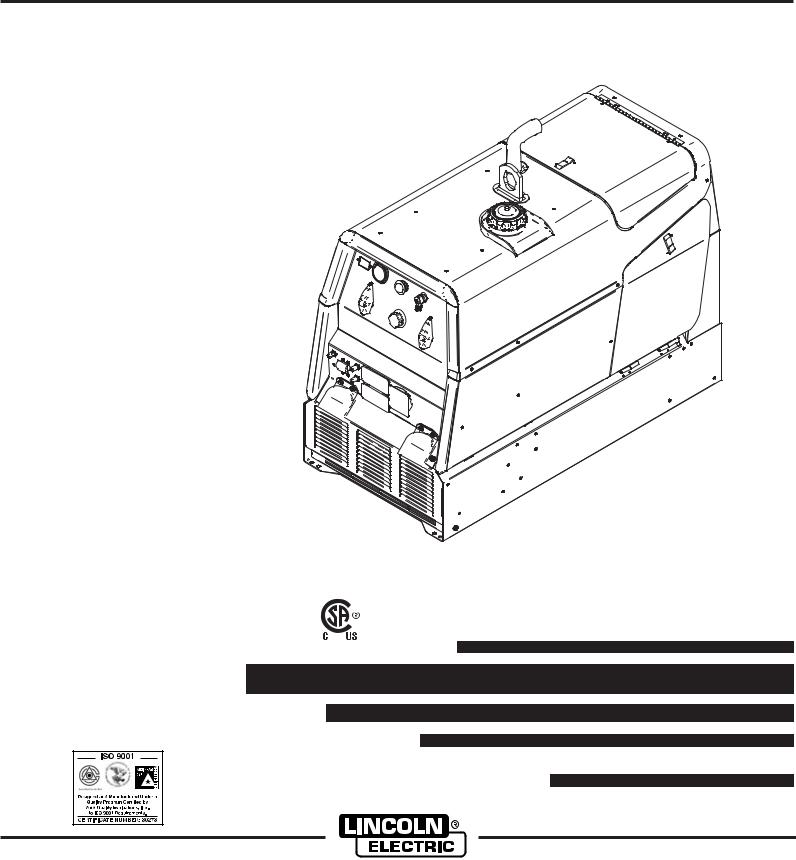
RETURN TO MAIN MENU
® |
IM969 |
RANGER 225 GXT |
December, 2008 |
|
For Machines with Code Number 11522
Safety Depends on You
Lincoln arc welding and cutting equipment is designed and built with safety in mind. However, your overall safety can be increased by proper installation ... and thoughtful operation on your part. DO NOT INSTALL, OPERATE OR REPAIR THIS EQUIPMENT WITHOUT READING THIS MANUAL AND THE SAFETY PRECAUTIONS CONTAINED THROUGHOUT. A n d , m o s t importantly, think before you act and be careful.
OPERATOR’S MANUAL
Copyright © Lincoln Global Inc.
•World's Leader in Welding and Cutting Products •
•Sales and Service through Subsidiaries and Distributors Worldwide •
Cleveland, Ohio 44117-1199 U.S.A. TEL: 216.481.8100 FAX: 216.486.1751 WEB SITE: www.lincolnelectric.com
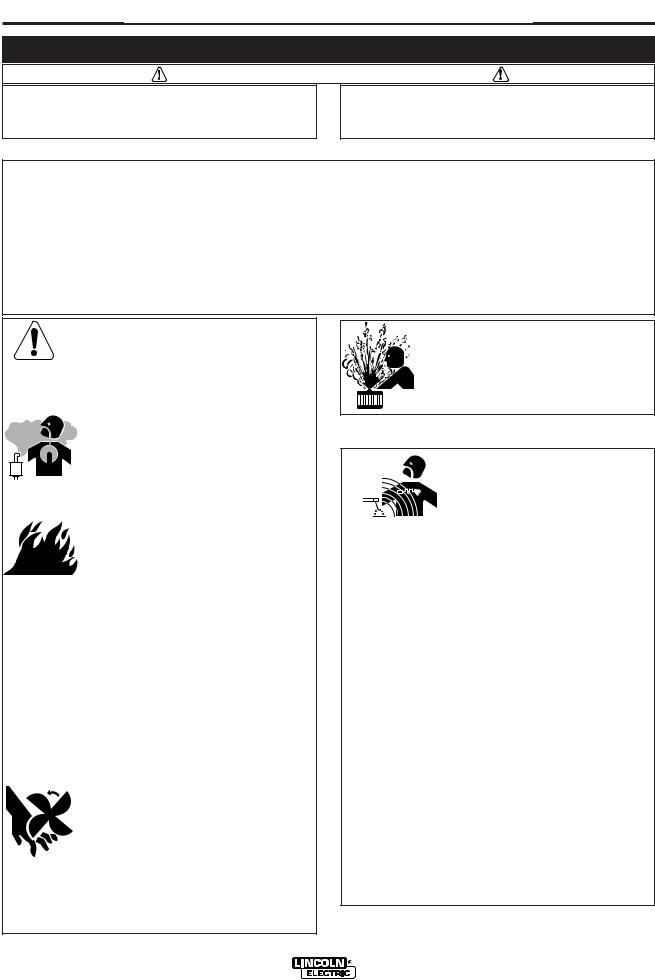
i
SAFETY
i
 WARNING
WARNING
CALIFORNIA PROPOSITION 65 WARNINGS
Diesel engine exhaust and some of its constituents are known to the State of California to cause cancer, birth defects, and other reproductive harm.
The Above For Diesel Engines
The engine exhaust from this product contains chemicals known to the State of California to cause cancer, birth defects, or other reproductive harm.
The Above For Gasoline Engines
ARC WELDING CAN BE HAZARDOUS. PROTECT YOURSELF AND OTHERS FROM POSSIBLE SERIOUS INJURY OR DEATH. KEEP CHILDREN AWAY. PACEMAKER WEARERS SHOULD CONSULT WITH THEIR DOCTOR BEFORE OPERATING.
Read and understand the following safety highlights. For additional safety information, it is strongly recommended that you purchase a copy of “Safety in Welding & Cutting - ANSI Standard Z49.1” from the American Welding Society, P.O. Box 351040, Miami, Florida 33135 or CSA Standard W117.2-1974. A Free copy of “Arc Welding Safety” booklet E205 is available from the Lincoln Electric Company, 22801 St. Clair Avenue, Cleveland, Ohio 44117-1199.
BE SURE THAT ALL INSTALLATION, OPERATION, MAINTENANCE AND REPAIR PROCEDURES ARE PERFORMED ONLY BY QUALIFIED INDIVIDUALS.
FOR ENGINE powered equipment.
1.a. Turn the engine off before troubleshooting and maintenance work unless the maintenance work requires it to be running.
____________________________________________________
1.b. Operate engines in open, well-ventilated areas or vent the engine exhaust fumes
outdoors.
____________________________________________________
1.c. Do not add the fuel near an open flame welding arc or when the engine is running.
Stop the engine and allow it to cool before refueling to prevent spilled fuel from vaporizing on contact with hot engine parts and igniting. Do not spill fuel when filling tank. If fuel is spilled, wipe it up and do not start engine until fumes have been eliminated.
____________________________________________________
1.d. Keep all equipment safety guards, covers and devices in position and in good repair.Keep hands, hair, clothing and tools away from V-belts, gears, fans and all other moving parts when starting, operating or repairing equipment.
____________________________________________________
1.e. In some cases it may be necessary to remove safety guards to perform required maintenance. Remove guards only when necessary and replace them when the maintenance requiring their removal is complete. Always use the greatest care when working near moving parts.
___________________________________________________
1.f. Do not put your hands near the engine fan. Do not attempt to override the governor or idler by pushing on the throttle control rods
while the engine is running.
___________________________________________________
1.g. To prevent accidentally starting gasoline engines while turning the engine or welding generator during maintenance work, disconnect the spark plug wires, distributor cap or magneto wire as appropriate.
1.h. To avoid scalding, do not remove the radiator pressure cap when the engine is hot.
ELECTRIC AND MAGNETIC FIELDS may be dangerous
2.a. Electric current flowing through any conductor causes localized Electric and Magnetic Fields (EMF). Welding current creates EMF fields around welding cables and welding machines
2.b. EMF fields may interfere with some pacemakers, and welders having a pacemaker should consult their physician before welding.
2.c. Exposure to EMF fields in welding may have other health effects which are now not known.
2.d. All welders should use the following procedures in order to minimize exposure to EMF fields from the welding circuit:
2.d.1. Route the electrode and work cables together - Secure them with tape when possible.
2.d.2. Never coil the electrode lead around your body.
2.d.3. Do not place your body between the electrode and work cables. If the electrode cable is on your right side, the work cable should also be on your right side.
2.d.4. Connect the work cable to the workpiece as close as possible to the area being welded.
2.d.5. Do not work next to welding power source.
Mar ʻ95
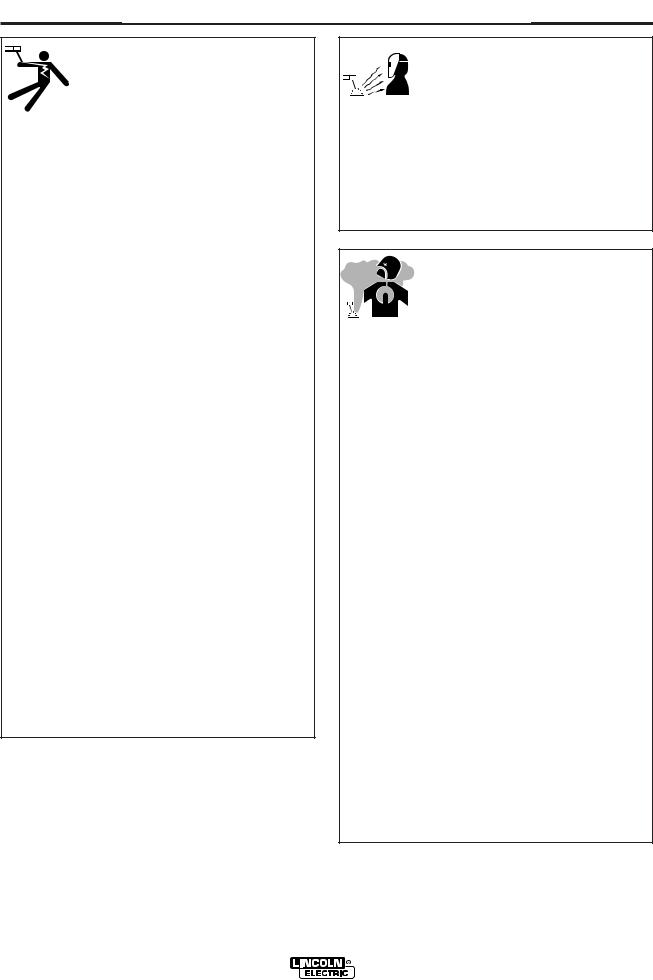
ii
SAFETY
ii
ELECTRIC SHOCK can
kill.
3.a. The electrode and work (or ground) circuits are electrically “hot” when the welder is on. Do not touch these “hot” parts with your bare skin or wet clothing. Wear dry, hole-free
gloves to insulate hands.
3.b. Insulate yourself from work and ground using dry insulation. Make certain the insulation is large enough to cover your full area of physical contact with work and ground.
In addition to the normal safety precautions, if welding must be performed under electrically hazardous conditions (in damp locations or while wearing wet clothing; on metal structures such as floors, gratings or scaffolds; when in cramped positions such as sitting, kneeling or lying, if there is a high risk of unavoidable or accidental contact with the workpiece or ground) use the following equipment:
•Semiautomatic DC Constant Voltage (Wire) Welder.
•DC Manual (Stick) Welder.
•AC Welder with Reduced Voltage Control.
3.c. In semiautomatic or automatic wire welding, the electrode, electrode reel, welding head, nozzle or semiautomatic welding gun are also electrically “hot”.
3.d. Always be sure the work cable makes a good electrical connection with the metal being welded. The connection should be as close as possible to the area being welded.
3.e. Ground the work or metal to be welded to a good electrical (earth) ground.
3.f. Maintain the electrode holder, work clamp, welding cable and welding machine in good, safe operating condition. Replace damaged insulation.
3.g. Never dip the electrode in water for cooling.
3.h. Never simultaneously touch electrically “hot” parts of electrode holders connected to two welders because voltage between the two can be the total of the open circuit voltage of both welders.
3.i. When working above floor level, use a safety belt to protect yourself from a fall should you get a shock.
3.j. Also see Items 6.c. and 8.
ARC RAYS can burn.
4.a. Use a shield with the proper filter and cover plates to protect your eyes from sparks and the rays of the arc when welding or observing open arc welding. Headshield and filter lens should conform to ANSI Z87. I standards.
4.b. Use suitable clothing made from durable flame-resistant material to protect your skin and that of your helpers from the arc rays.
4.c. Protect other nearby personnel with suitable, non-flammable screening and/or warn them not to watch the arc nor expose themselves to the arc rays or to hot spatter or metal.
FUMES AND GASES can be dangerous.
5.a. Welding may produce fumes and gases
hazardous to health. Avoid breathing these fumes and gases.When welding, keep your head out of the fume. Use enough ventilation and/or exhaust at the arc to keep
fumes and gases away from the breathing zone. When welding with electrodes which require special ventilation such as stainless or hard facing (see instructions on container or MSDS) or on lead or cadmium plated steel and other metals or coatings which produce highly toxic fumes, keep exposure as low as possible and below Threshold Limit Values (TLV) using local exhaust or mechanical ventilation. In confined spaces or in some circumstances, outdoors, a respirator may be required. Additional precautions are also required when welding on galvanized steel.
5.b. The operation of welding fume control equipment is affected by various factors including proper use and positioning of the equipment, maintenance of the equipment and the specific welding procedure and applicaiton involved. Worker exposure level should be checked upon installation and periodically thereafter to be certain it is within applicable OSHA PEL and ACGIH TLV limits.
5.c. Do not weld in locations near chlorinated hydrocarbon vapors coming from degreasing, cleaning or spraying operations. The heat and rays of the arc can react with solvent vapors to form phosgene, a highly toxic gas, and other irritating products.
5.d. Shielding gases used for arc welding can displace air and cause injury or death. Always use enough ventilation, especially in confined areas, to insure breathing air is safe.
5.e. Read and understand the manufacturerʼs instructions for this equipment and the consumables to be used, including the material safety data sheet (MSDS) and follow your employerʼs safety practices. MSDS forms are available from your welding distributor or from the manufacturer.
5.f. Also see item 1.b.
AUG 06
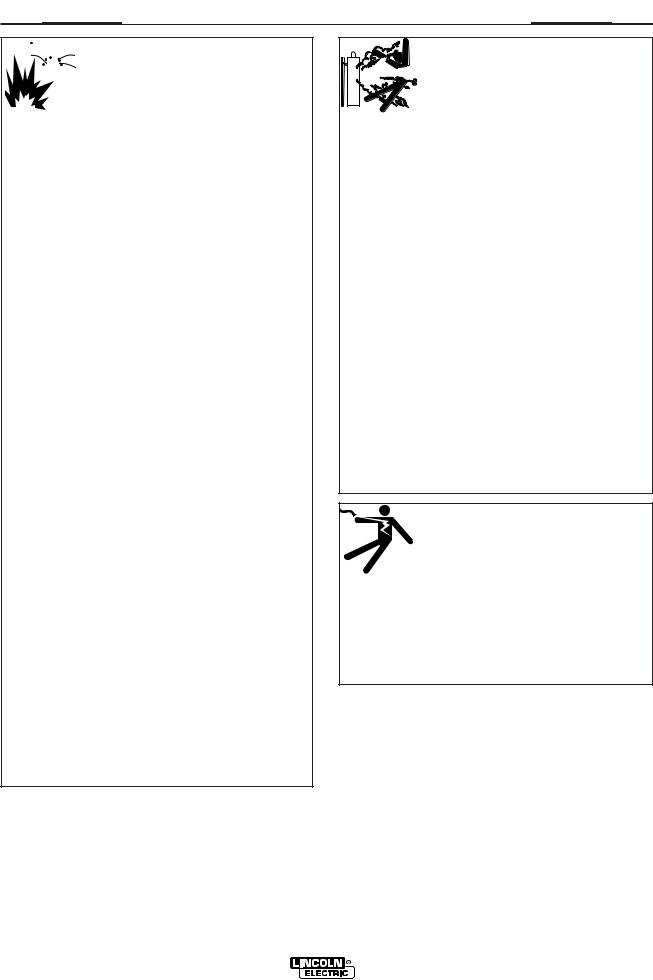
iii
SAFETY
iii

 WELDING and CUTTING
WELDING and CUTTING

 SPARKS can
SPARKS can
cause fire or explosion.
6.a. Remove fire hazards from the welding area. If this is not possible, cover them to prevent the welding sparks from starting a fire.
Remember that welding sparks and hot materials from welding can easily go through small cracks and openings to adjacent areas. Avoid welding near hydraulic lines. Have a fire extinguisher readily available.
6.b. Where compressed gases are to be used at the job site, special precautions should be used to prevent hazardous situations. Refer to “Safety in Welding and Cutting” (ANSI Standard Z49.1) and the operating information for the equipment being used.
6.c. When not welding, make certain no part of the electrode circuit is touching the work or ground. Accidental contact can cause overheating and create a fire hazard.
6.d. Do not heat, cut or weld tanks, drums or containers until the proper steps have been taken to insure that such procedures will not cause flammable or toxic vapors from substances inside. They can cause an explosion even though they have been “cleaned”. For information, purchase “Recommended Safe Practices for the Preparation for Welding and Cutting of Containers and Piping That Have Held Hazardous Substances”, AWS F4.1 from the American Welding Society (see address above).
6.e. Vent hollow castings or containers before heating, cutting or welding. They may explode.
6.f. Sparks and spatter are thrown from the welding arc. Wear oil free protective garments such as leather gloves, heavy shirt, cuffless trousers, high shoes and a cap over your hair. Wear ear plugs when welding out of position or in confined places. Always wear safety glasses with side shields when in a welding area.
6.g. Connect the work cable to the work as close to the welding area as practical. Work cables connected to the building framework or other locations away from the welding area increase the possibility of the welding current passing through lifting chains, crane cables or other alternate circuits. This can create fire hazards or overheat lifting chains or cables until they fail.
6.h. Also see item 1.c.
6.I. Read and folllow NFPA 51B “ Standard for Fire Prevention During Welding, Cutting and Other Hot Work”, available from NFPA, 1 Batterymarch Park,PO box 9101, Quincy, Ma 022690-9101.
6.j. Do not use a welding power source for pipe thawing.
CYLINDER may explode






 if damaged.
if damaged.
7.a. Use only compressed gas cylinders
containing the correct shielding gas for the process used and properly operating regulators designed for the gas and
pressure used. All hoses, fittings, etc. should be suitable for the application and maintained in good condition.
7.b. Always keep cylinders in an upright position securely chained to an undercarriage or fixed support.
7.c. Cylinders should be located:
•Away from areas where they may be struck or subjected to physical damage.
•A safe distance from arc welding or cutting operations and any other source of heat, sparks, or flame.
7.d. Never allow the electrode, electrode holder or any other electrically “hot” parts to touch a cylinder.
7.e. Keep your head and face away from the cylinder valve outlet when opening the cylinder valve.
7.f. Valve protection caps should always be in place and hand tight except when the cylinder is in use or connected for use.
7.g. Read and follow the instructions on compressed gas cylinders, associated equipment, and CGA publication P-l, “Precautions for Safe Handling of Compressed Gases in Cylinders,” available from the Compressed Gas Association 1235 Jefferson Davis Highway, Arlington, VA 22202.
FOR ELECTRICALLY powered equipment.
8.a. Turn off input power using the disconnect switch at the fuse box before working on the equipment.
8.b. Install equipment in accordance with the U.S. National Electrical Code, all local codes and the manufacturerʼs recommendations.
8.c. Ground the equipment in accordance with the U.S. National Electrical Code and the manufacturerʼs recommendations.
Jan, 07

iv
SAFETY
iv
PRÉCAUTIONS DE SÛRETÉ
Pour votre propre protection lire et observer toutes les instructions et les précautions de sûreté specifiques qui parraissent dans ce manuel aussi bien que les précautions de sûreté générales suivantes:
Sûreté Pour Soudage A LʼArc
1.Protegez-vous contre la secousse électrique:
a.Les circuits à lʼélectrode et à la piéce sont sous tension quand la machine à souder est en marche. Eviter toujours tout contact entre les parties sous tension et la peau nue ou les vétements mouillés. Porter des gants secs et sans trous pour isoler les mains.
b.Faire trés attention de bien sʼisoler de la masse quand on soude dans des endroits humides, ou sur un plancher metallique ou des grilles metalliques, principalement dans les positions assis ou couché pour lesquelles une grande partie du corps peut être en contact avec la masse.
c.Maintenir le porte-électrode, la pince de masse, le câble de soudage et la machine à souder en bon et sûr état defonctionnement.
d.Ne jamais plonger le porte-électrode dans lʼeau pour le refroidir.
e.Ne jamais toucher simultanément les parties sous tension des porte-électrodes connectés à deux machines à souder parce que la tension entre les deux pinces peut être le total de la tension à vide des deux machines.
f.Si on utilise la machine à souder comme une source de courant pour soudage semi-automatique, ces precautions pour le porte-électrode sʼapplicuent aussi au pistolet de soudage.
2.Dans le cas de travail au dessus du niveau du sol, se protéger contre les chutes dans le cas ou on recoit un choc. Ne jamais enrouler le câble-électrode autour de nʼimporte quelle partie du corps.
3.Un coup dʼarc peut être plus sévère quʼun coup de soliel, donc:
a.Utiliser un bon masque avec un verre filtrant approprié ainsi quʼun verre blanc afin de se protéger les yeux du rayonnement de lʼarc et des projections quand on soude ou quand on regarde lʼarc.
b.Porter des vêtements convenables afin de protéger la peau de soudeur et des aides contre le rayonnement de lʻarc.
c.Protéger lʼautre personnel travaillant à proximité au soudage à lʼaide dʼécrans appropriés et non-inflammables.
4.Des gouttes de laitier en fusion sont émises de lʼarc de soudage. Se protéger avec des vêtements de protection libres de lʼhuile, tels que les gants en cuir, chemise épaisse, pantalons sans revers, et chaussures montantes.
5.Toujours porter des lunettes de sécurité dans la zone de soudage. Utiliser des lunettes avec écrans lateraux dans les zones où lʼon pique le laitier.
6.Eloigner les matériaux inflammables ou les recouvrir afin de prévenir tout risque dʼincendie dû aux étincelles.
7.Quand on ne soude pas, poser la pince à une endroit isolé de la masse. Un court-circuit accidental peut provoquer un échauffement et un risque dʼincendie.
8.Sʼassurer que la masse est connectée le plus prés possible de la zone de travail quʼil est pratique de le faire. Si on place la masse sur la charpente de la construction ou dʼautres endroits éloignés de la zone de travail, on augmente le risque de voir passer le courant de soudage par les chaines de levage, câbles de grue, ou autres circuits. Cela peut provoquer des risques dʼincendie ou dʼechauffement des chaines et des câbles jusquʼà ce quʼils se rompent.
9.Assurer une ventilation suffisante dans la zone de soudage. Ceci est particuliérement important pour le soudage de tôles galvanisées plombées, ou cadmiées ou tout autre métal qui produit des fumeés toxiques.
10.Ne pas souder en présence de vapeurs de chlore provenant dʼopérations de dégraissage, nettoyage ou pistolage. La chaleur ou les rayons de lʼarc peuvent réagir avec les vapeurs du solvant pour produire du phosgéne (gas fortement toxique) ou autres produits irritants.
11.Pour obtenir de plus amples renseignements sur la sûreté, voir le code “Code for safety in welding and cutting” CSA Standard W 117.2-1974.
PRÉCAUTIONS DE SÛRETÉ POUR LES MACHINES À SOUDER À TRANSFORMATEUR ET À REDRESSEUR
1.Relier à la terre le chassis du poste conformement au code de lʼélectricité et aux recommendations du fabricant. Le dispositif de montage ou la piece à souder doit être branché à une bonne mise à la terre.
2.Autant que possible, Iʼinstallation et lʼentretien du poste seront effectués par un électricien qualifié.
3.Avant de faires des travaux à lʼinterieur de poste, la debrancher à lʼinterrupteur à la boite de fusibles.
4.Garder tous les couvercles et dispositifs de sûreté à leur place.
Mar. ʻ93
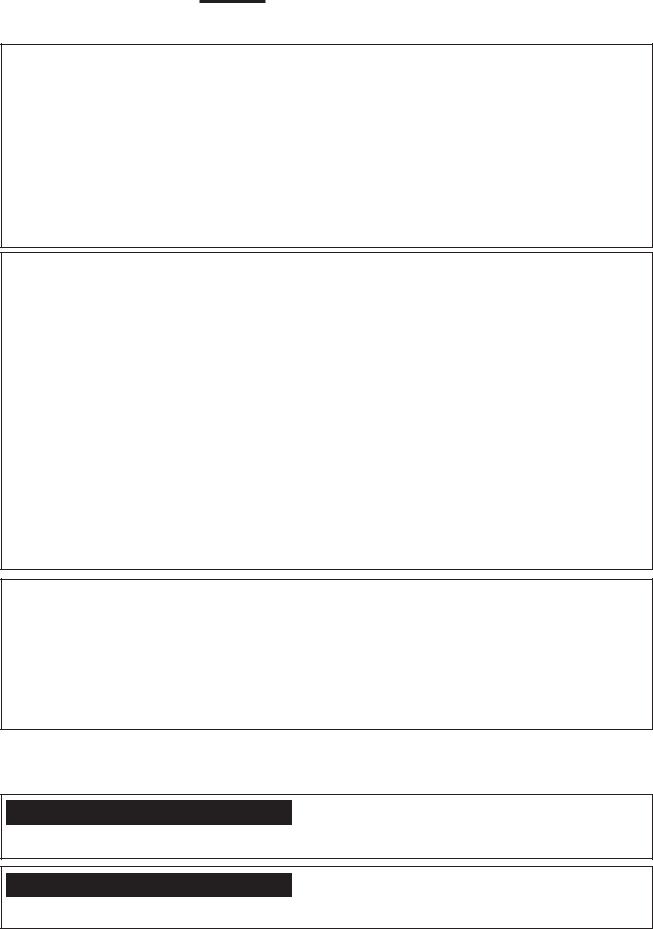
v
Thank You
v for selecting a QUALITY product by Lincoln Electric. We want you to take pride in operating this Lincoln Electric Company product
••• as much pride as we have in bringing this product to you!
CUSTOMER ASSISTANCE POLICY
The business of The Lincoln Electric Company is manufacturing and selling high quality welding equipment, consumables, and cutting equipment. Our challenge is to meet the needs of our customers and to exceed their expectations. On occasion, purchasers may ask Lincoln Electric for advice or information about their use of our products. We respond to our customers based on the best information in our possession at that time. Lincoln Electric is not in a position to warrant or guarantee such advice, and assumes no liability, with respect to such information or advice. We expressly disclaim any warranty of any kind, including any warranty of fitness for any customerʼs particular purpose, with respect to such information or advice. As a matter of practical consideration, we also cannot assume any responsibility for updating or correcting any such information or advice once it has been given, nor does the provision of information or advice create, expand or alter any warranty with respect to the sale of our products.
Lincoln Electric is a responsive manufacturer, but the selection and use of specific products sold by Lincoln Electric is solely within the control of, and remains the sole responsibility of the customer. Many variables beyond the control of Lincoln Electric affect the results obtained in applying these types of fabrication methods and service requirements.
Subject to Change – This information is accurate to the best of our knowledge at the time of printing. Please refer to www.lincolnelectric.com for any updated information.
Please Examine Carton and Equipment For Damage Immediately
When this equipment is shipped, title passes to the purchaser upon receipt by the carrier. Consequently, Claims for material damaged in shipment must be made by the purchaser against the transportation company at the time the shipment is received.
Please record your equipment identification information below for future reference. This information can be found on your machine nameplate.
Product _________________________________________________________________________________
Model Number ___________________________________________________________________________
Code Number or Date Code_________________________________________________________________
Serial Number____________________________________________________________________________
Date Purchased___________________________________________________________________________
Where Purchased_________________________________________________________________________
Whenever you request replacement parts or information on this equipment, always supply the information you have recorded above. The code number is especially important when identifying the correct replacement parts.
On-Line Product Registration
-Register your machine with Lincoln Electric either via fax or over the Internet.
•For faxing: Complete the form on the back of the warranty statement included in the literature packet accompanying this machine and fax the form per the instructions printed on it.
•For On-Line Registration: Go to our WEB SITE at www.lincolnelectric.com. Choose “Quick Links” and then
“Product Registration”. Please complete the form and submit your registration.
Read this Operators Manual completely before attempting to use this equipment. Save this manual and keep it handy for quick reference. Pay particular attention to the safety instructions we have provided for your protection. The level of seriousness to be applied to each is explained below:
 WARNING
WARNING
This statement appears where the information must be followed exactly to avoid serious personal injury or loss of life.
 CAUTION
CAUTION
This statement appears where the information must be followed to avoid minor personal injury or damage to this equipment.
vi |
TABLE OF CONTENTS |
vi |
|
|
Page |
Installation....................................................................................................................... |
|
Section A |
Technical Specifications....................................................................................................... |
A-1 |
|
Safety Precautions ........................................................................................................ |
A-2 |
|
Machine Grounding....................................................................................................... |
A-2 |
|
Spark Arrester ............................................................................................................... |
|
A-2 |
Towing........................................................................................................................... |
|
A-2 |
Vehicle Mounting........................................................................................................... |
|
A-3 |
Pre-Operation Engine Service.............................................................................................. |
A-3 |
|
Fuel, Oil, Battery Connections ...................................................................................... |
A-3 |
|
Welding Cable Connections.......................................................................................... |
A-4 |
|
Angle of Operation ........................................................................................................ |
A-4 |
|
Lifting, Additional Safety Precautions............................................................................ |
A-4 |
|
High Altitude Operation ................................................................................................. |
A-4 |
|
Muffler Outlet Pipe ........................................................................................................ |
A-4 |
|
Location and Ventilation................................................................................................ |
A-5 |
|
Stacking ........................................................................................................................ |
|
A-5 |
Connection of Wire Feeders ......................................................................................... |
A-5 |
|
Connection of Tig Module ............................................................................................. |
A-5 |
|
Additional Safety Precautions ....................................................................................... |
A-5 |
|
Welding Operation Output, Auxiliary Power Receptacles, and Plugs ................................. |
A-6 |
|
Motor Starting and Extension Cord Length Table ................................................................ |
A-6 |
|
Electrical Device Used with the Ranger 10,000 ................................................................... |
A-7 |
|
Auxiliary Power While |
Welding, Standby Power Connections ............................................ |
A-8 |
Premises Wiring ................................................................................................................... |
|
A-9 |
________________________________________________________________________________ |
||
Operation......................................................................................................................... |
|
Section B |
Safety Precautions ............................................................................................................... |
|
B-1 |
General Description.............................................................................................................. |
|
B-1 |
Welder Controls Function and Operation ............................................................................. |
B-1 |
|
Range, Polarity Control Switch and Fuel Consumption ....................................................... |
B-2 |
|
Start in/Shutdown Instructions..................................................................................................... |
B-3 |
|
Starting the Engine........................................................................................................ |
B-3 |
|
Safety Precautions ........................................................................................................ |
B-3 |
|
Stopping the Engine...................................................................................................... |
B-3 |
|
Break-In Period ............................................................................................................. |
|
B-3 |
Welding Process .................................................................................................................. |
|
B-4 |
Stick (Constant Current) Welding.................................................................................. |
B-4 |
|
TIG (Constant Current) Welding .................................................................................. |
B-4 |
|
Wire Feed Welding Processes (Constant Voltage)...................................................... |
B-4 |
|
Arc Gouging .................................................................................................................. |
|
B-4 |
Summary of Welding Processes ................................................................................... |
B-5 |
|
________________________________________________________________________________ |
||
Accessories ........................................................................................................ |
|
Section C |
Optional Equipment............................................................................................... |
|
C-1 |
Recommended Equipment.................................................................................... |
C-2 |
|
________________________________________________________________________ |
||
Maintenance .................................................................................................... |
|
Section D |
Safety Precautions ................................................................................................ |
|
D-1 |
Routine Engine Maintenance .......................................................................... |
D-1,D2 |
|
Engine Adjustments............................................................................................... |
|
D-3 |
Slip Rings .............................................................................................................. |
|
D-3 |
Battery Maintenance ....................................................................................... |
D-3 |
|
Engine Maintenance Parts.............................................................................. |
D-3 |
|
________________________________________________________________________ |
||
Troubleshooting.............................................................................................. |
|
Section E |
How to Use Troubleshooting Guide....................................................................... |
E-1 |
|
Troubleshooting Guide................................................................................... |
E-2, E-3 |
|
________________________________________________________________________ |
||
Wiring Diagrams & Dimension Print.............................................................. |
Section F |
|
Wiring and Connection Diagrams.................................................................... |
F-1,F-2 |
|
Dimension Print ............................................................................................................. |
|
F3 |
________________________________________________________________________ |
||
Parts List................................................................................................................. |
|
P-581 |
________________________________________________________________________
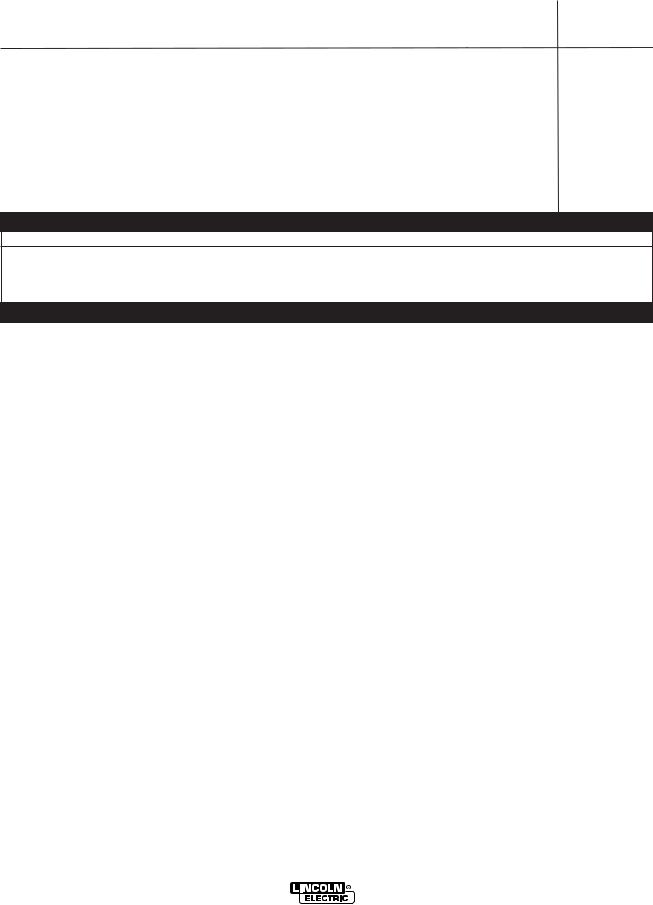
|
A-1 |
|
INSTALLATION |
|
|
A-1 |
|||
|
TECHNICAL SPECIFICATIONS - RANGER® 225 GXT ( K2733-1) |
|
|
|
|
||||
|
|
|
|
|
|
|
|
|
|
|
|
|
INPUT - GASOLINE ENGINE |
|
|
|
|
||
|
Make/Model |
Description |
Horsepower |
Operating |
Displacement |
|
Starting |
Capacities |
|
|
|
|
|
Speed (RPM) |
cu. in. |
|
System |
|
|
|
|
|
|
|
(cu.cm.) |
|
|
|
|
|
|
2 cylinder |
|
High Idle 3700 |
|
|
12VDC |
|
|
|
|
4 Cycle |
|
|
|
|
|
||
|
|
|
|
|
|
|
|
||
|
|
|
|
|
|
Battery |
|
|
|
|
|
Air-Cooled |
|
|
|
|
Fuel: |
|
|
|
|
|
|
|
|
Electric Start |
|
||
|
|
Gasoline |
|
|
|
|
|
||
|
Kohler |
23 HP @ |
Full Load 3500 |
41.1(674) |
|
Group 58 |
12 Gal (45.4 L) |
|
|
|
Engine. |
|
|
||||||
|
CH23S |
Aluminum Alloy |
3600 RPM |
|
|
|
Battery |
Lubricating Oil: |
|
|
|
with Cast Iron |
|
|
|
|
(435 cold |
2.0 Qts. (1.9 L) |
|
|
|
|
Low Idle 2200 |
|
|
Cranking |
|
|
|
|
|
Liners, |
|
|
|
|
|
||
|
|
|
|
|
|
Amps) |
|
|
|
|
|
Electronic |
|
|
|
|
|
|
|
|
|
|
|
|
|
|
|
|
|
|
|
Ignition |
|
|
|
|
|
|
|
|
|
|
|
|
|
|
|
|
|
|
|
|
|
|
|
|
|
|
|
RATED OUTPUT @ 104°F (40°C)- WELDER
Welding Output
AC Constant Current 225A / 25V / 100%
DC Constant Current 210A / 25V / 100%
DC Constant Voltage 200A / 20V / 100%
RATED OUTPUT @ 104°F (40°C)- GENERATOR
|
|
|
|
Auxiliary Power 1 |
|
|
|
|
|||
|
|
|
9,000 Watts Continuous, 60 Hz AC |
|
|
|
|
||||
|
|
|
10,500 Watts Peak, 60 Hz AC |
|
|
|
|
||||
|
|
|
|
120/240 Volts |
|
|
|
|
|||
|
|
|
|
|
|
|
|
|
|
|
|
|
|
RECEPTACLES AND CIRCUIT BREAKERS |
|||||||||
RECEPTACLES |
|
AUXILIARY POWER CIRCUIT BREAKER |
BATTERY CHARGING CIRCUIT BREAKER |
||||||||
(2) 120VAC Duplex (5-20R) |
Two 20AMP for Two Duplex Receptacle |
|
|
20AMP for Engine Battery |
|||||||
(1) 120/240VAC Dual Voltage |
(1) 40AMP for Dual Voltage (2-pole) |
|
|
|
Charging Circuit |
||||||
Full KVA (14-50R) |
|
|
|
|
|
|
|
|
|
|
|
|
|
|
|
|
|
|
|
|
|
|
|
|
|
|
PHYSICAL DIMENSIONS |
|
|
|
|
|
|
||
HEIGHT |
|
WIDTH |
|
DEPTH |
|
|
|
WEIGHT |
|||
30.00** in. |
|
21.50 in |
|
42.25 in. |
|
|
|
|
|
||
762.0 mm |
|
546.0 mm |
|
1073.0 mm |
|
|
|
567 lbs. (257kg) |
|
||
|
|
|
|
|
|
|
|||||
|
|
|
|
|
|
|
|
|
|
|
|
|
|
|
|
|
|
|
|
|
|||
** Top of enclosure, add 6.00”(152mm) for exhaust. |
|
|
|
|
|
|
|
|
|||
|
|
|
|
|
|
|
|
|
|
|
|
|
|
|
ENGINE COMPONENTS |
|
|
|
|
||||
LUBRICATION |
|
VALVE LIFTERS |
|
FUEL SYSTEM |
|
|
GOVERNOR |
||||
Full Pressure |
|
Hydraulic |
Mechanical Fuel Pump |
|
|
Mechanical Governor |
|||||
with Full Flow Filter |
|
|
|
Additional electric fuel lift pump |
|
|
|
|
|||
5% Regulation |
|
|
|
on K2382-4. |
|
|
|
|
|||
|
|
|
|
|
|
|
|
|
|||
AIR CLEANER |
|
ENGINE IDLER |
|
MUFFLER |
|
ENGINE PROTECTION |
|||||
|
|
|
|
Low noise Muffler: Top outlet |
|
|
Shutdown on low oil |
||||
Dual Element |
|
Automatic Idler |
can be rotated. Made from |
|
|
pressure. |
|||||
|
|
|
|
long life, aluminized steel. |
|
|
|
|
|||
|
|
|
|
|
|
|
|
|
|
|
|
1Output rating in watts is equivalent to volt - amperes at unity factor.Output voltage is within +/-10% at all loads up to rated capacity. When welding available auxiliary power will be reduced.
RANGER® 225 GXT
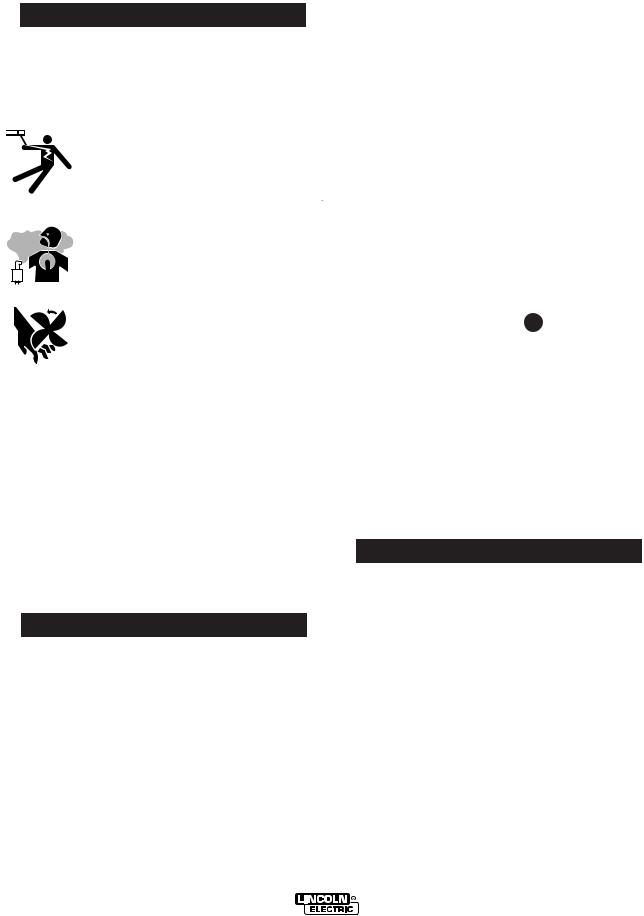
A-2 |
INSTALLATION |
A-2 |
SAFETY PRECAUTIONS
 WARNING
WARNING
Do not attempt to use this equipment until you have thoroughly read the engine manufacturerʼs manual supplied with your welder. It includes important safety precautions, detailed engine starting, operating and maintenance instructions, and parts lists.
------------------------------------------------------------------------
ELECTRIC SHOCK can kill.
•Do not touch electrically live parts or electrode with skin or wet clothing.
•Insulate yourself from work and ground
•Always wear dry insulating gloves.
------------------------------------------------------------------------
ENGINE EXHAUST can kill.
•Use in open, well ventilated areas or
vent exhaust outside.
------------------------------------------------------------------------
MOVING PARTS can injure.
• Do not operate with doors open or guards off.
• Stop engine before servicing.
• Keep away from moving parts.
------------------------------------------------------------------------
See additional warning information at front of this operatorʼs manual.
-----------------------------------------------------------
MACHINE GROUNDING
Because this portable engine driven welder or generator creates itʼs own power, it is not necessary to connect itʼs frame to an earth ground, unless the machine is connected to premises wiring (your home, shop, etc.).
 WARNING
WARNING
To prevent dangerous electric shock, other equipment to which this engine driven welder supplies power must:
•be grounded to the frame of the welder using a grounded type plug, or be double insulated.
Do not ground the machine to a pipe that carries explosive or combustible material.
------------------------------------------------------------------------
When this welder is mounted on a truck or trailer, itʼs frame must be electrically bonded to the metal frame of the vehicle. Use a #8 or larger copper wire connected between the machine grounding stud and the frame of the vehicle.
Where this engine driven welder is connected to premises wiring such as that in your home or shop, itʼs frame must be connected to the system earth ground. See further connection instructions in the section entitled “Standby Power Connections”, as well as the article on grounding in the latest National Electrical Code and the local code.
In general, if the machine is to be grounded, it should be connected with a #8 or larger copper wire to a solid earth ground such as a metal water pipe going into the ground for at least ten feet and having no insulated joints, or to the metal framework of a building which has been effectively grounded. The National Electrical Code lists a number of alternate means of grounding electrical equipment. A machine grounding stud marked with the symbol is provided on the front of the welder.
SPARK ARRESTER
Some federal, state, or local laws may require that gasoline engines be equipped with exhaust spark arresters when they are operated in certain locations where unarrested sparks may present a fire hazard. The standard muffler included with this welder does not qualify as a spark arrester. When required by local regulations, the K1898-1 spark arrester must be installed and properly maintained.
 CAUTION
CAUTION
An incorrect arrester may lead to damage to the engine or adversely affect performance.
------------------------------------------------------------------------
TOWING
The recommended trailer for use with this equipment for road, in-plant and yard towing by a vehicle(1) is Lincolnʼs K2635-1. If the user adapts a non-Lincoln trailer, he must assume responsibility that the method of attachment and usage does not result in a safety hazard nor damage the welding equipment. Some of the factors to be considered are as follows:
1.Design capacity of trailer vs. weight of Lincoln equipment and likely additional attachments.
2.Proper support of, and attachment to, the base of the welding equipment so there will be no undue stress to the framework.
RANGER® 225 GXT
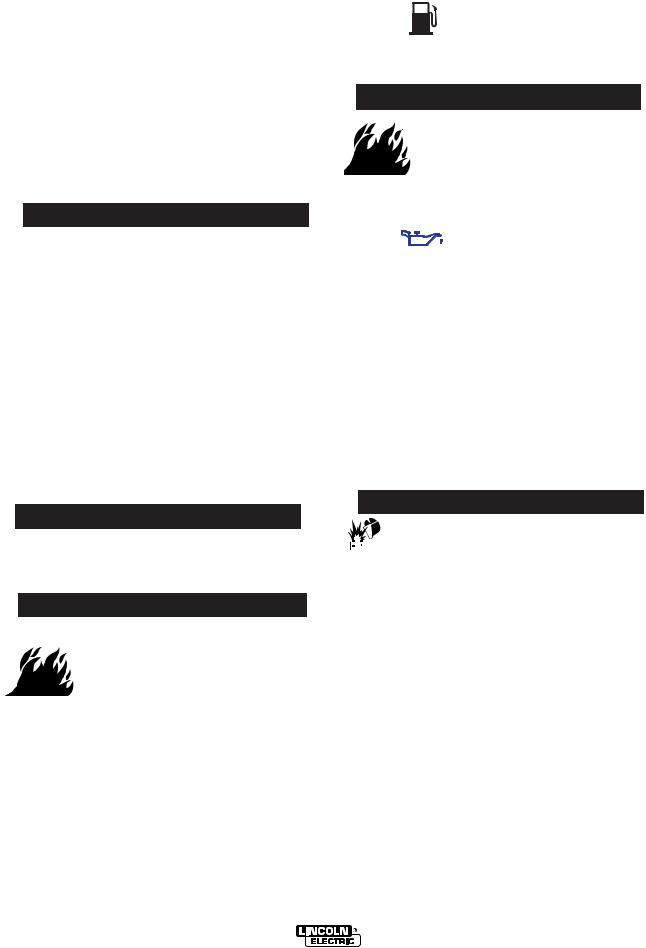
A-3 |
INSTALLATION |
A-3 |
3.Proper placement of the equipment on the trailer to insure stability side to side and front to back when being moved and when standing by itself while being operated or serviced.
4.Typical conditions of use, i.e., travel speed; roughness of surface on which the trailer will be operated; environmental conditions.
5.Conformance with federal, state and local laws(1)
(1)Consult applicable federal, state and local laws regarding specific requirements for use on public highways.
VEHICLE MOUNTING
 WARNING
WARNING
Improperly mounted concentrated loads may cause unstable vehicle handling and tires or other components to fail.
•Only transport this Equipment on serviceable vehicles which are rated and designed for such loads.
•Distribute, balance and secure loads so vehicle is stable under conditions of use.
•Do not exceed maximum rated loads for components such as suspension, axles and tires.
•Mount equipment base to metal bed or frame of vehicle.
•Follow vehicle manufacturerʼs instructions.
------------------------------------------------------------------------
PRE-OPERATION SERVICE
 CAUTION
CAUTION
READ the engine operating and maintenance instructions supplied with this machine.
 WARNING
WARNING
GASOLINE can cause fire or explosion.
•Stop engine while fueling.
•Do not smoke when fueling.
•Keep sparks and flame away from tank.
•Do not leave unattended while fueling.
•Wipe up spilled fuel and allow fumes to clear before starting engine.
•Do not overfill tank, fuel expansion may cause overflow.
GASOLINE FUEL ONLY
------------------------------------------------------------------------
FUEL
Fill the fuel tank with clean, fresh, lead-free gasoline. Observe fuel gauge while filling to prevent overfilling.
 WARNING
WARNING
• Damage to the fuel tank may cause fire or explosion. Do not drill holes in the RANGER® 225 GXT base or weld to the RANGER® 225 GXT base.
-----------------------------------------------------------------------
OIL
LUBRICATION SYSTEM CAPACITY
(INCLUDING FILTER)
Kohler CH23S - 2.0 Quarts (1.9 Liters)
The RANGER® 225 GXT is shipped with the engine crankcase filled with SAE 10W-30 oil. Check the oil level before starting the engine. If it is not up to the full mark on the dip stick, add oil as required. Make certain that the oil filler cap is tightened securely. Refer to the engine Ownerʼs Manual for specific oil recommendations.
BATTERY CONNECTIONS
 CAUTION
CAUTION
Use caution as the electrolyte is a strong acid that can burn skin and damage eyes.
-----------------------------------------------------------------------
This welder is shipped with the negative battery cable disconnected. Make sure that the Engine Switch is in the “STOP” position and attach the disconnected cable securely to the negative battery terminal before attempting to operate the machine. If the battery is discharged and does not have enough power to start the engine, see the battery charging instructions in the Battery section.
NOTE: This machine is furnished with a wet charged battery; if unused for several months, the battery may require a booster charge. Be careful to charge the battery with the correct polarity.
RANGER® 225 GXT
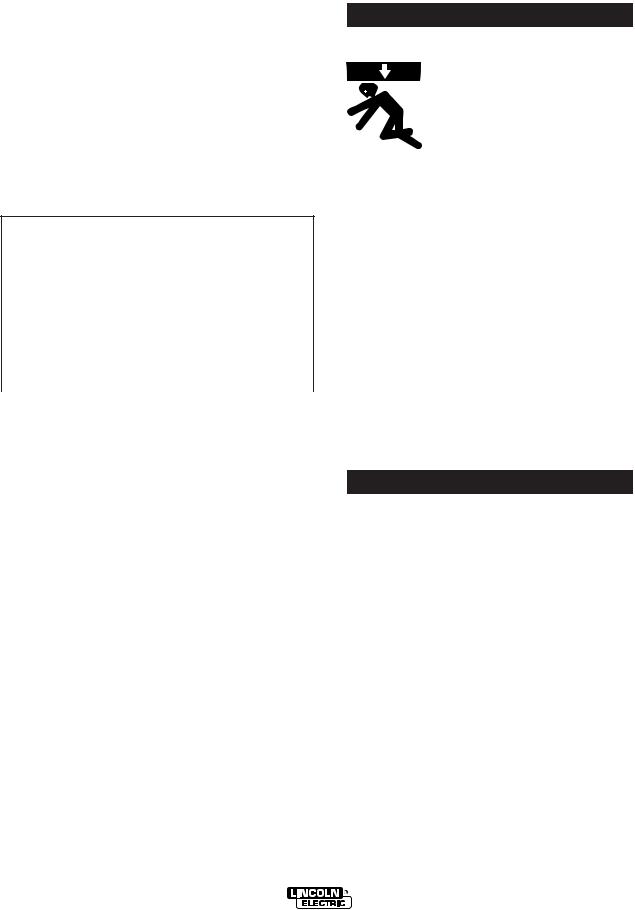
A-4 |
INSTALLATION |
A-4 |
WELDING OUTPUT CABLES
With the engine off, connect the electrode and work cables to the studs provided. These connections should be checked periodically and tightened if necessary. Loose connections will result in overheating of the output studs.
When welding at a considerable distance from the welder, be sure you use ample size welding cables. Listed below are copper cable sizes recommended for the rated current and duty cycle. Lengths stipulated are the distance from the welder to work and back to the welder again. Cable sizes are increased for greater lengths primarily for the purpose of minimizing cable voltage drop.
TOTAL COMBINED LENGTH OF ELECTRODE AND WORK CABLES
|
|
|
|
|
|
|
|
|
|
|
|
|
225 Amps |
|
|
|
|
|
|
|
100% Duty Cycle |
|
|
|
|
|
|
|
|
|
|
|
|
|
|
|
1 AWG |
|
|
|
|
0-100 Ft. (0-31m) |
|||||
|
|
|
|
|
|
|
|
|
|
100-150 Ft. (31-46m) |
|
|
1 AWG |
|
|
|
|
|
|
|
|
|
|
|
|
150-200 Ft. (46-61m) |
|
|
1/0 AWG |
|
|
|
|
|
|
|
|
|
|
|
|
|
|
|
|
|
|
ANGLE OF OPERATION
Internal combustion engines are designed to run in a level condition which is where the optimum performance is achieved. The maximum angle of operation for the engine is 15 degrees from horizontal in any direction. If the engine is to be operated at an angle, provisions must be made for checking and maintaining the oil at the normal (FULL) oil capacity in the crankcase in a level condition.
When operating at an angle, the effective fuel capacity will be slightly less than the specified 12 Gal. (45 L).
LIFTING
The RANGER® 225 GXT weighs approximately 685lbs.(411kg) with a full tank of gasoline. A lift bail is mounted to the machine and should always be used when lifting the machine.
ADDITIONAL SAFETY PRECAUTION
 WARNING
WARNING
•Lift only with equipment of adequate lifting capacity.
•Be sure machine is stable
|
when lifting. |
|
• Do not lift this machine using |
|
lift bail if it is equipped with a |
|
heavy accessory such as trail- |
|
er or gas cylinder. |
FALLING |
• Do not lift machine if lift bail is |
EQUIPMENT can |
damaged. |
cause injury. |
• Do not operate machine while |
|
suspended from lift bail. |
------------------------------------------------------------------------
HIGH ALTITUDE OPERATION
At higher altitudes, Welder output de-rating may be necessary. For maximum rating, de-rate the welder output 3.5% for every 1000 ft. (305m) above 3000 ft. (914m). If operation will consistently be at altitudes above 5,000 ft. (1525m), a carburetor jet designed for high altitudes should be installed. This will result in better fuel economy, cleaner exhaust and longer spark plug life. It will not give increased power. Contact your local authorized engine service shop for high altitude jet kits that are available from the engine manufacturer.
 CAUTION
CAUTION
Do not operate with a high altitude jet installed at altitudes below 5000 ft. This will result in the engine running too lean and result in higher engine operating temperatures which can shorten engine life.
------------------------------------------------------------------------
MUFFLER OUTLET PIPE
Using the clamp provided secure the outlet pipe to the outlet tube with the pipe positioned such that it will direct the exhaust in the desired direction. Tighten using a 9/16” socket or wrench.
RANGER® 225 GXT
